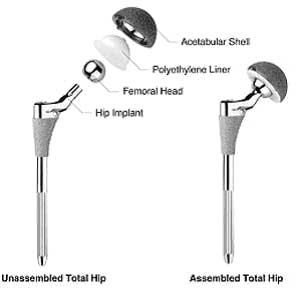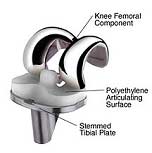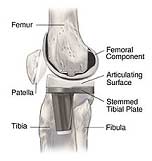|
Q. What causes knee pain?
A. There are many different causes of knee pain, including injury,
arthritis and infection.
Q. Is there a cure?
A. It depends on the problem. Some knee pain can be treated through
rehabilitation, other cases may require surgery.
Q. What is a knee replacement?
A. In total knee replacement surgery, the parts of the bones that rub
together are resurfaced with metal and plastic implants. Using special,
precision instruments, your surgeon will typically remove the damaged
surfaces of all three bones. The replacement surfaces will then be fixed
into place.
The surface of the femur is replaced with a rounded metal component that
comes very close to matching the curve of your natural bone. The surface
of the tibia is replaced with a smooth plastic component. This flat metal
component holds a smooth plastic piece made of ultra-high-molecular-weight
polyethylene plastic that serves as the cartilage. The under surface of
the kneecap may also be replaced with an implant made of the same
polyethylene plastic.
Q. How do I know if I need a knee replacement?
A. If you have difficulty walking or performing everyday activities such as
getting dressed, it may be time to consider knee replacement surgery.
Doctors generally try to delay total knee replacement for as long as
possible in favor of less invasive treatments. However for patients with
advanced joint disease, knee replacement offers the chance for relief from
pain and a return to normal activities.
Q. How do I prepare for knee replacement surgery?
A. If you and your surgeon decide that total knee replacement is right for
you, a date will be scheduled for your surgery. Several things may be
necessary to prepare for surgery. For example, your surgeon might ask you
to have a physical examination by an internist or your regular
doctor.
Because blood transfusions are likely to be needed during your surgery,
you may want to donate one unit of your own blood, or possibly two units
if your surgeon feels it is needed. All preparations for surgery should be
discussed with your surgeon.
Q. What happens during knee replacement surgery?
A. On the day of surgery, a small tube (intravenous line) will be inserted
into your arm. This tube will be used to administer antibiotics and other
medication during your surgery. You will then be taken to the operating
room and given anesthesia. After the anesthesia takes effect, your knee
will be scrubbed and sterilized with a special solution.
The surgery will begin with an incision over the knee that will expose the
joint. When the bones are fully visible to the surgeon, special, precision
guides and instruments are used to remove the damaged surfaces and shape
the ends of the bones to accept the implants.
The implants are then secured to the bones. It might also be necessary to
adjust the ligaments that surround the knee in order to achieve the best
possible knee function. When the surgeon is satisfied with the fit and
function of the implants, the incision will be closed.
A special drain may be inserted into the wound to drain the fluids that
naturally develop at the surgical site. A sterile bandage will then be
applied, and you will be taken to the recovery room, where you will be
closely monitored. Your surgery will likely take between one and three
hours, depending on your individual circumstances.
As your anesthesia wears off, you will slowly regain consciousness. A
nurse will be with you, and may encourage you to cough or breath deeply to
help clear your lungs. You will also be given pain medication. When you
are fully awake, you will be taken to your hospital room. Your knee will
remain swollen and tender for a few days.
Q. How is the implant affixed in the body?
A. Generally, implant systems are affixed to the body in one of three
ways:
-
Cemented with bone cement
-
Cementless (biologic ingrowth)
-
Combination of 1 & 2
-
Bone Cement
-
A special type of acrylic bone cement may be used to secure some or all
of the implant components to the bone. If used, the bone cement takes
about 15 minutes to set.
-
Cementless
-
In other cases, the implants may be implanted into the bone without
cement. These components have a special porous coating that allows tissue
to grow into it for fixation.
-
Combination
In some cases, your surgeon may choose a combination of cement and
cementless attachment, depending upon the implant components and the
condition of the bone around the knee joint.
The decision as to whether to use a cemented or cementless component
depends upon many factors, including the intended use of the product,
surgeon philosophy and the patientís condition.
Q. What can I expect after knee replacement surgery?
A. When you are back in your hospital room, you will begin a rehabilitation
program that will help you regain strength, balance, and range of movement
in your knee. This program will be designed specifically for you. It may
include a machine, called a continuous passive motion machine that
automatically moves your leg to help reduce stiffness.
Your physical therapist will help you perform appropriate exercises. About
24 hours after surgery, you will probably be asked to stand. Within the
next 24 hours, you will probably begin to walk a few steps with the help
of a walker. You will be discharged as soon as your surgeon determined
that you have recovered sufficiently. You can expect to stay in the
hospital for about three days after your surgery. You may or may not be
transferred to a rehabilitation facility for a few more days, as
determined by your surgeon. Your bandages and sutures will usually be
removed before you leave the hospital. At home, you will need to continue
your exercises. Your physical therapist will instruct you about proper
home care, and may continue to work with you.
Q. How soon can I return to normal activities after surgery?
A. Within six weeks after surgery, most patients are able to walk with a
cane. You will probably feel well enough to drive a car within seven to
eight weeks after surgery.
In most cases, successful joint replacement surgery will relieve your pain
and stiffness, and allow you to resume many of your normal daily
activities. But even after you have fully recovered from your surgery, you
will still have some restrictions. Normal daily activities do not include
contact sports or activities that put excessive strain on your joints.
Although your artificial joint can be replaced, a second implant is seldom
as effective as the first.
Q. Will an implant set off a metal detector?
A. Since knee implants are made of metal, thereís a chance they could set
off metal detectors.
Patients have reported mixed experiences at airports: some detectors go
off and some donít.
You may be provided with a special card to keep in your wallet explaining
that you have a knee implant.
Q. How common is knee replacement surgery?
A. Knee replacement is a routine surgery performed on over 600,000 people
worldwide each year. Over 90% of people who have had Total Knee
Replacement experience an improvement in knee pain and function.
Q. How old is the average patient?
A. In the U.S., the average joint replacement patient is around 65-70 years
old, however patients of all ages have received knee implants.
Q. What about sex?
A. Doctors generally allow patients to resume sexual activities as soon as
they feel able. In the months following surgery, patients are generally
advised to take it easy and modify their positioning to keep pressure off
of the joint while itís healing. As always, it is best to consult with
your doctor about whatís safe for your particular condition.
Q. I am knock-kneed/bow-legged. Can knee replacement surgery correct
this?
A. Many people are born with a natural tendency toward knock-knees or
bowlegged ness. However, severe arthritis can lead to an uncomfortable
degree of misalignment.
One of the goals of total knee replacement is to restore your bodyís
natural alignment. Zimmer has special instrumentation to help surgeons
replicate natural, optimum alignment.
Q. How much does a knee implant cost? Is it covered by insurance?
A. The cost of a total knee implant varies, depending on the type of
implant used. Typically, a total knee procedure includes four major
implant components and the total implant price ranges from $4000 to $6500
(USD).
In most countries, the hospital purchases the implant and includes it as
part of the total cost for the surgery.
Standard total knee replacement surgery is generally covered by most
insurance plans. You will need to check with your particular healthcare
plan for details.
Q. How long will a joint replacement last?
A. Longevity of the prosthetic knee varies from patient to patient. It
depends on many factors, such as a patient's physical condition, activity
level, and weight, as well as the accuracy of implant placement during
surgery. It is useful to keep in mind that prosthetic joints are not as
strong or durable as a natural, healthy joint, and there is no guarantee
that a prosthetic joint will last the rest of a patient's life.
Today, total knee replacement has become a common and predictable
procedure. Many patients enjoy relief from pain and improved function,
compared to their status before surgery. As a result, some patients may
have unrealistic expectations about what the prosthetic knee can do and
how much activity it can withstand. As with any mechanical joint, the knee
components move against each other. Natural fluid in the joint space,
called synovial fluid, helps to lubricate the implants just as it
lubricates the bones and cartilage in a natural joint. Still, the
prosthetic components do wear as they roll and slide against each other
during movement. As with car tires or brake pads, the rate of wear depends
partly on how the knee joint is used. Activities that place a lot of
stress on the joint implants, as may be the case with heavier and more
active patients, may reduce the service life of the prosthesis. Implant
loosening and wear on the plastic portions of the implant can lead to the
necessity for revision surgery to replace the worn components, or all of
the components. Your doctor will be in the best position to discuss these
issues with you, taking into account your particular clinical
circumstances, the type of implants used, and your post-surgical
lifestyle.
Talk with your doctor about the following points, and how they might
affect the longevity and success of your knee replacement:
-
Avoiding repetitive heavy lifting
-
Avoiding excessive stair climbing
-
Maintaining appropriate weight
-
Staying healthy and active
-
Avoiding "impact loading" sports such as jogging, downhill
skiing and high impact aerobics
-
Consulting your surgeon before beginning any new sport or
activity
-
Thinking before you move
-
Avoiding any physical activities involving quick stop-start motion,
twisting or impact stresses
-
Avoiding excessive bending when weight bearing, like climbing steep
stairs
-
Not lifting or pushing heavy objects
-
Not kneeling
-
Avoiding low seating surfaces and chairs
Q. What is a hip replacement?
A. In a total hip replacement surgery, the painful parts of the damaged hip
are replaced with artificial hip parts called a prosthesis, a device that
substitutes or supplements a joint. The prosthesis consists of steel
components: a socket, ball, and stem. The outer shell of the socket is
usually made of metal and the inner shell consists of plastic, or the
entire socket may be plastic. When the metal ball is joined with the
socket, the new hip can allow for smooth, nearly frictionless
movement.

Q. How do I know if I need a hip replacement?
A. If you have difficulty walking or performing everyday activities such as
getting dressed, it may be time to consider hip replacement surgery.
Doctors generally try to delay total hip replacement for as long as
possible in favor of less invasive treatments. However in patients with
advanced joint disease, hip replacement offers the chance for relief from
pain and a return to normal activities.
Q. How do I prepare for hip replacement surgery?
A. If you and your surgeon decide that total hip replacement is right for
you, a date will be scheduled for your surgery. Several things may be
necessary to prepare for surgery. For example, your surgeon might ask you
to have a physical examination by your primary care physician. This will
help to ensure that other health problems you may have, such as diabetes
or high blood pressure, will be identified and treated before
surgery.
You doctor may suggest that you lose weight and initiate an exercise
program. If you smoke, be sure to speak with your doctor about it, as
smoking can dangerously increase surgical risks and slow down the healing
process.
You should also finish any dental work that may be underway to prevent
germs in your mouth from entering the bloodstream and infecting the joint.
It is likely that you will need blood during hip surgery, and your surgeon
may place an order with the blood bank in case a transfusion is needed. If
you prefer, or if your surgeon feels it is needed, you may want to donate
your own blood ahead of time to reduce the risk of your body reacting to
the blood transfusion. Read the Surgery Calendar for more information on
how to prepare for surgery.
Q. What happens during hip replacement surgery?
A. On the day of surgery, an intravenous tube will be inserted into your
arm to administer necessary medications and fluids during surgery. You
will then be taken to the operating room and given anesthesia.
The surgery usually takes two to four hours, although this is dependent
upon the severity of the arthritis in your hip. In the operating room, a
urinary catheter will be inserted and left in place for one or two days.
Compression stockings and pneumatic sleeves will be put on both legs. The
procedure is performed through an incision over the side of the hip. The
ball-end of the thighbone (femur) is cut and replaced with the new metal
ball and stem component. It may be stabilized with or without cement. The
damaged surface of the socket is smoothed in preparation for the insertion
of the new socket. The ball and socket are then joined. When the surgeon
is satisfied with the fit and function, the incision will be cleaned and
covered with dressings. You will also find small drainage tubes coming out
of the hip to drain fluid from the wound.
You will be sent to the recovery room and as the anesthesia wears off you
will slowly regain consciousness. A nurse will be with you, and may
encourage you to cough or breathe deeply to help clear your lungs. You
will also be given pain medication and will find a foam wedge or pillows
placed between your legs to help hold your joint in place. When you are
fully conscious, you will be taken back to your hospital room.
Q. How long does the surgery take? What is the recovery time?
A. In the weeks immediately following surgery, you may need walking aids
such as a cane or crutches. Within a few months, however, you should be
able to return to normal activities.
For more information, please read, Your Hip Surgery and After Hip
Surgery.
Q. Are there any complications?
A. Some common complications specific to hip replacement surgery include
loosening or dislocation of the implant and a slight difference in leg
length.
Your healthcare team will discuss these possible complications with you
and the precautions taken against them.
Q. What activities can I do or not do after receiving a hip implant?
A. Typically, patients are advised to avoid high impact sports such as
jogging, basketball, racquetball, gymnastics, etc.
Safer activities may include walking, golf, swimming, and bicycling.
Your doctor will advise you on safe activities for your particular
condition.
Q. Will a hip implant last a lifetime?
A. The longevity of a prosthetic hip (how long it will last) varies from
patient to patient. It depends on many factors, such as a patient's
physical condition and activity level, body weight and the surgical
technique. A prosthetic joint is not as strong or durable as a natural,
healthy joint, and there is no guarantee that a prosthetic joint will last
the rest of a patient's life. All prosthetic hips may need to be revised
(replaced) at some point.
Q. How much does a hip implant cost? Is it covered by insurance?
A. The cost of a total hip implant varies, depending on the type of implant
used. Typically, a total hip procedure includes four major implant
components and the total implant price ranges from $6500 to $7000 (USD).
In most countries, the hospital purchases the implant and includes it as
part of the total cost for the surgery.
Standard total hip replacement surgery is generally covered by most
insurance plans. You will need to check with your particular healthcare
plan for details.
Back
|






 Channel Partners
Channel Partners